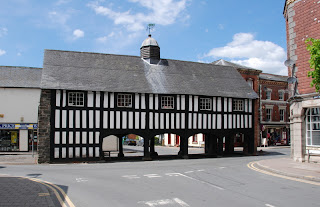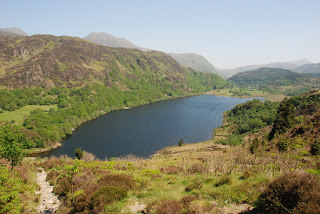For many years we have
being saying that we must visit the Welsh national coal mining museum
of Big Pit but we never seemed to have time when we were in the area.
This time we had planned it better and the stop at Pandy allowed us
to visit the museum on the way home. Blaenafon is a UNESCO World
Heritage Site due to its industrial landscape, which includes Big
Pit.
We arrived early and
joined those waiting for the first underground tour at 10:00
conducted by an ex-miner. We were the only English people included in
a tour with a French school party from Toulouse. They were very well
behaved and really enjoyed the tour. The young teacher worked really
hard translating instructions and information from our tour guide
especially when you consider all of the technical terms that she had
to first understand before she translated them. It was fun hearing
both the English and the French and I realised how little French I
remembered from my school days!
The tour took us in
cages down the shaft to lower levels and we then walked along a
series of tunnels to see coal faces and equipment and to hear about
the lives of the miners. We were told about mining in the 19th
century when women hauled the tubs of coal and children (boys and
girls) worked from the age of 4. The children often started as
'trappers', chained to a ventilation door in total darkness and
charged with the duty of opening the door for miners when they
passed. The chain allowed them to find their way back to the chairs
in the dark but also prevented them from leaving. As the only English
speaking man in the party, I volunteered to act as 'trapper' as we
walked around the mine, ensuring that every door was properly closed
after we had passed through and I was given a 'payment' of a tiny
piece of Welsh steam coal by the guide at the end tour.
After the excellent
underground, we spent another couple of hours exploring the above
ground exhibits which included a very good audio-visual tour of a
simulated mine. Other interesting buildings were the winding house
(still in use for the cages) and the bath house that was only
installed in 1939, before which the miners returned home filthy. The
museum told us much more about the life of miners and their families.
It was shocking to find out that the life expectancy of miners' wives
were at one time lower that the miners themselves mainly due to the
hard work and poverty that they had to endure.
Big Pit is gives an
excellent insight into coal mining in the Welsh coalfields, the
underground tour is excellent and the museum and exhibits
fascinating. It is really worth a visit and, incredibly, it is free.
Go and see it soon whilst there are still ex-miner tour guides who
can tell you about their lives.
So it was back to
Somerset and the end of this sojourn. It will be great to see our
family and friends and we are looking forward to the village
celebrations for the Diamond Jubilee that include a street party and
an ox roast!
Photos: An overview of
Big Pit; The powerful motors of the winding house.






















